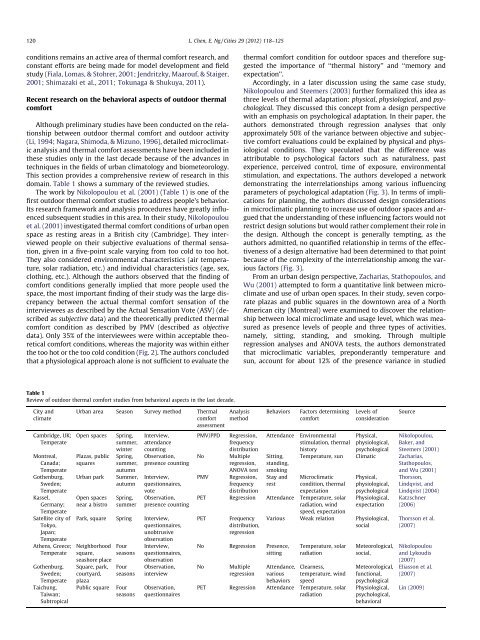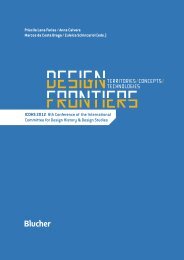Outdoor thermal comfort and outdoor activities: A review of research ...
Outdoor thermal comfort and outdoor activities: A review of research ...
Outdoor thermal comfort and outdoor activities: A review of research ...
You also want an ePaper? Increase the reach of your titles
YUMPU automatically turns print PDFs into web optimized ePapers that Google loves.
120 L. Chen, E. Ng / Cities 29 (2012) 118–125<br />
conditions remains an active area <strong>of</strong> <strong>thermal</strong> <strong>comfort</strong> <strong>research</strong>, <strong>and</strong><br />
constant efforts are being made for model development <strong>and</strong> field<br />
study (Fiala, Lomas, & Stohrer, 2001; Jendritzky, Maarouf, & Staiger,<br />
2001; Shimazaki et al., 2011; Tokunaga & Shukuya, 2011).<br />
Recent <strong>research</strong> on the behavioral aspects <strong>of</strong> <strong>outdoor</strong> <strong>thermal</strong><br />
<strong>comfort</strong><br />
Although preliminary studies have been conducted on the relationship<br />
between <strong>outdoor</strong> <strong>thermal</strong> <strong>comfort</strong> <strong>and</strong> <strong>outdoor</strong> activity<br />
(Li, 1994; Nagara, Shimoda, & Mizuno, 1996), detailed microclimatic<br />
analysis <strong>and</strong> <strong>thermal</strong> <strong>comfort</strong> assessments have been included in<br />
these studies only in the last decade because <strong>of</strong> the advances in<br />
techniques in the fields <strong>of</strong> urban climatology <strong>and</strong> biometeorology.<br />
This section provides a comprehensive <strong>review</strong> <strong>of</strong> <strong>research</strong> in this<br />
domain. Table 1 shows a summary <strong>of</strong> the <strong>review</strong>ed studies.<br />
The work by Nikolopoulou et al. (2001) (Table 1) is one <strong>of</strong> the<br />
first <strong>outdoor</strong> <strong>thermal</strong> <strong>comfort</strong> studies to address people’s behavior.<br />
Its <strong>research</strong> framework <strong>and</strong> analysis procedures have greatly influenced<br />
subsequent studies in this area. In their study, Nikolopoulou<br />
et al. (2001) investigated <strong>thermal</strong> <strong>comfort</strong> conditions <strong>of</strong> urban open<br />
space as resting areas in a British city (Cambridge). They interviewed<br />
people on their subjective evaluations <strong>of</strong> <strong>thermal</strong> sensation,<br />
given in a five-point scale varying from too cold to too hot.<br />
They also considered environmental characteristics (air temperature,<br />
solar radiation, etc.) <strong>and</strong> individual characteristics (age, sex,<br />
clothing, etc.). Although the authors observed that the finding <strong>of</strong><br />
<strong>comfort</strong> conditions generally implied that more people used the<br />
space, the most important finding <strong>of</strong> their study was the large discrepancy<br />
between the actual <strong>thermal</strong> <strong>comfort</strong> sensation <strong>of</strong> the<br />
interviewees as described by the Actual Sensation Vote (ASV) (described<br />
as subjective data) <strong>and</strong> the theoretically predicted <strong>thermal</strong><br />
<strong>comfort</strong> condition as described by PMV (described as objective<br />
data). Only 35% <strong>of</strong> the interviewees were within acceptable theoretical<br />
<strong>comfort</strong> conditions, whereas the majority was within either<br />
the too hot or the too cold condition (Fig. 2). The authors concluded<br />
that a physiological approach alone is not sufficient to evaluate the<br />
Table 1<br />
Review <strong>of</strong> <strong>outdoor</strong> <strong>thermal</strong> <strong>comfort</strong> studies from behavioral aspects in the last decade.<br />
City <strong>and</strong><br />
climate<br />
Cambridge, UK;<br />
Temperate<br />
Montreal,<br />
Canada;<br />
Temperate<br />
Gothenburg,<br />
Sweden;<br />
Temperate<br />
Kassel,<br />
Germany;<br />
Temperate<br />
Satellite city <strong>of</strong><br />
Tokyo,<br />
Japan;<br />
Temperate<br />
Athens, Greece;<br />
Temperate<br />
Gothenburg,<br />
Sweden;<br />
Temperate<br />
Taichung,<br />
Taiwan;<br />
Subtropical<br />
Urban area Season Survey method Thermal<br />
<strong>comfort</strong><br />
assessment<br />
Open spaces Spring,<br />
summer,<br />
winter<br />
Plazas, public<br />
squares<br />
Spring,<br />
summer,<br />
autumn<br />
Urban park Summer,<br />
autumn<br />
Open spaces<br />
near a bistro<br />
Spring,<br />
summer<br />
Interview,<br />
attendance<br />
counting<br />
Observation,<br />
presence counting<br />
Interview,<br />
questionnaires,<br />
vote<br />
Observation,<br />
presence counting<br />
Park, square Spring Interview,<br />
questionnaires,<br />
unobtrusive<br />
observation<br />
Neighborhood<br />
square,<br />
Four<br />
seasons<br />
seashore place<br />
Square, park, Four<br />
courtyard, seasons<br />
plaza<br />
Public square Four<br />
seasons<br />
Interview,<br />
questionnaires,<br />
observation<br />
Observation,<br />
interview<br />
Observation,<br />
questionnaires<br />
Analysis<br />
method<br />
PMV/PPD Regression,<br />
frequency<br />
distribution<br />
No Multiple<br />
regression,<br />
ANOVA test<br />
PMV Regression,<br />
frequency<br />
distribution<br />
<strong>thermal</strong> <strong>comfort</strong> condition for <strong>outdoor</strong> spaces <strong>and</strong> therefore suggested<br />
the importance <strong>of</strong> ‘‘<strong>thermal</strong> history’’ <strong>and</strong> ‘‘memory <strong>and</strong><br />
expectation’’.<br />
Accordingly, in a later discussion using the same case study,<br />
Nikolopoulou <strong>and</strong> Steemers (2003) further formalized this idea as<br />
three levels <strong>of</strong> <strong>thermal</strong> adaptation: physical, physiological, <strong>and</strong> psychological.<br />
They discussed this concept from a design perspective<br />
with an emphasis on psychological adaptation. In their paper, the<br />
authors demonstrated through regression analyses that only<br />
approximately 50% <strong>of</strong> the variance between objective <strong>and</strong> subjective<br />
<strong>comfort</strong> evaluations could be explained by physical <strong>and</strong> physiological<br />
conditions. They speculated that the difference was<br />
attributable to psychological factors such as naturalness, past<br />
experience, perceived control, time <strong>of</strong> exposure, environmental<br />
stimulation, <strong>and</strong> expectations. The authors developed a network<br />
demonstrating the interrelationships among various influencing<br />
parameters <strong>of</strong> psychological adaptation (Fig. 3). In terms <strong>of</strong> implications<br />
for planning, the authors discussed design considerations<br />
in microclimatic planning to increase use <strong>of</strong> <strong>outdoor</strong> spaces <strong>and</strong> argued<br />
that the underst<strong>and</strong>ing <strong>of</strong> these influencing factors would not<br />
restrict design solutions but would rather complement their role in<br />
the design. Although the concept is generally tempting, as the<br />
authors admitted, no quantified relationship in terms <strong>of</strong> the effectiveness<br />
<strong>of</strong> a design alternative had been determined to that point<br />
because <strong>of</strong> the complexity <strong>of</strong> the interrelationship among the various<br />
factors (Fig. 3).<br />
From an urban design perspective, Zacharias, Stathopoulos, <strong>and</strong><br />
Wu (2001) attempted to form a quantitative link between microclimate<br />
<strong>and</strong> use <strong>of</strong> urban open spaces. In their study, seven corporate<br />
plazas <strong>and</strong> public squares in the downtown area <strong>of</strong> a North<br />
American city (Montreal) were examined to discover the relationship<br />
between local microclimate <strong>and</strong> usage level, which was measured<br />
as presence levels <strong>of</strong> people <strong>and</strong> three types <strong>of</strong> <strong>activities</strong>,<br />
namely, sitting, st<strong>and</strong>ing, <strong>and</strong> smoking. Through multiple<br />
regression analyses <strong>and</strong> ANOVA tests, the authors demonstrated<br />
that microclimatic variables, preponderantly temperature <strong>and</strong><br />
sun, account for about 12% <strong>of</strong> the presence variance in studied<br />
Behaviors Factors determining<br />
<strong>comfort</strong><br />
Attendance Environmental<br />
stimulation, <strong>thermal</strong><br />
history<br />
Sitting,<br />
st<strong>and</strong>ing,<br />
smoking<br />
Stay <strong>and</strong><br />
rest<br />
Levels <strong>of</strong><br />
consideration<br />
Physical,<br />
physiological,<br />
psychological<br />
Source<br />
Nikolopoulou,<br />
Baker, <strong>and</strong><br />
Steemers (2001)<br />
Temperature, sun Climatic Zacharias,<br />
Stathopoulos,<br />
<strong>and</strong> Wu (2001)<br />
Microclimatic<br />
condition, <strong>thermal</strong><br />
expectation<br />
PET Regression Attendance Temperature, solar<br />
radiation, wind<br />
speed, expectation<br />
PET Frequency<br />
distribution,<br />
regression<br />
No Regression Presence,<br />
sitting<br />
No Multiple<br />
regression<br />
Physical,<br />
physiological,<br />
psychological<br />
Physiological,<br />
expectation<br />
Various Weak relation Physiological,<br />
social<br />
Attendance,<br />
various<br />
behaviors<br />
Temperature, solar<br />
radiation<br />
Clearness,<br />
temperature, wind<br />
speed<br />
PET Regression Attendance Temperature, solar<br />
radiation<br />
Meteorological,<br />
social,<br />
Meteorological,<br />
functional,<br />
psychological<br />
Physiological,<br />
psychological,<br />
behavioral<br />
Thorsson,<br />
Lindqvist, <strong>and</strong><br />
Lindqvist (2004)<br />
Katzschner<br />
(2006)<br />
Thorsson et al.<br />
(2007)<br />
Nikolopoulou<br />
<strong>and</strong> Lykoudis<br />
(2007)<br />
Eliasson et al.<br />
(2007)<br />
Lin (2009)
















